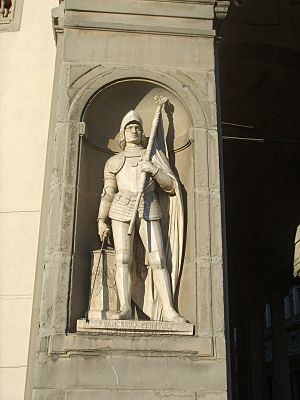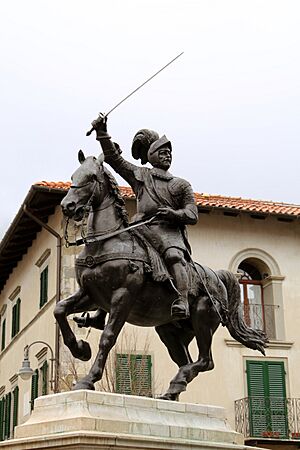Francesco Ferruccio facts for kids
Quick facts for kids
Francesco Ferruccio
|
|
|---|---|

Statue of Francesco Ferruccio at the Uffizi
|
|
| Native name |
Francesco Ferrucci
|
| Born | August 14, 1489 Florence, Republic of Florence |
| Died | August 3, 1530 (aged 40) Gavinana, Republic of Florence |
| Allegiance | Florentine Republic |
| Years of service | 1527–1530 |
| Rank | Commissioner General |
| Battles/wars | Battle of Gavinana Siege of Florence (1529–1530) War of the League of Cognac |
Francesco Ferruccio (also known as Ferrucci) was born in 1489 and died on August 3, 1530. He was a brave Italian military leader from Florence. Ferruccio fought during the Italian Wars, a time when many conflicts happened across Italy. He is remembered as a hero who fiercely defended the Republic of Florence.
Contents
Ferruccio's Early Life and Military Career
Francesco Ferruccio first worked as a clerk for a merchant. However, he soon decided to become a soldier. He began his military training under a famous captain named Giovanni de' Medici. Giovanni's soldiers were known as the "Black Bands" because of their black insignia. Ferruccio fought with them in different parts of Italy. He quickly gained a reputation as a very daring and brave fighter.
Defending Florence from Attack
During the War of the League of Cognac, Pope Clement VII and Emperor Charles V wanted to bring the Medici family back to power in Florence. The Medici had previously ruled Florence. To do this, they attacked the Florentine Republic.
Ferruccio was chosen to be a Florentine military commissioner. This meant he was a high-ranking military leader. He showed great courage and skill. He made quick marches and launched surprise attacks against the Imperial forces (the Emperor's army).
The Battle for Volterra and a Bold Plan
In early 1530, the city of Volterra had stopped supporting Florence. Imperial soldiers took control of it. But Ferruccio surprised them and took the city back for Florence.
While Ferruccio was away, the Imperial army captured Empoli. This was a problem because Empoli was a main route to Florence. Ferruccio then suggested a very bold plan to the Florentine government. He wanted to march on Rome and threaten the Pope. He hoped this would make the Pope agree to peace with Florence on good terms.
However, the war committee thought his plan was too risky. They made him commissioner-general for operations outside Florence, but they rejected his idea to attack Rome.
Ferruccio's Last Stand at Gavinana
Ferruccio then decided to try a different approach. He planned to attack the Imperial forces from behind. He left Volterra and headed towards the Apennine Mountains. But he became sick with a fever in Pisa and had to rest for a month. This delay allowed the enemy to learn about his plan and prepare for his attack.
In late July, Ferruccio left Pisa with about 4,000 soldiers. The people trapped inside Florence knew that a large part of the Imperial army, led by the Prince of Orange, had gone to meet Ferruccio. They wanted to help Ferruccio by launching an attack from the city. However, their own commander, Malatesta II Baglioni, prevented them from doing so. He was secretly working against Florence.
On August 3, Ferruccio's army met a much larger enemy force at Gavinana. The battle was desperate. At first, Ferruccio's attack pushed the Imperial soldiers back. The Prince of Orange himself was killed. But then, 2,000 more soldiers called Landsknechts arrived. They were led by Fabrizio Maramaldo.
The Florentine army was almost completely destroyed. Ferruccio was wounded and captured. Maramaldo, holding a personal grudge, killed Ferruccio himself. According to popular stories, Ferruccio's last words to Maramaldo were: "Vile, tu uccidi un uomo morto!" which means "Coward, you kill a dead man!"
This defeat sealed the fate of the Florentine Republic. Nine days later, Florence surrendered. Maramaldo's action made him forever infamous. His last name even became a word in Italian, maramaldeggiare, which means "to bully a defenseless victim."
Ferruccio's Legacy: A Hero for Italy
After his death, Ferruccio became a symbol of courage and sacrifice. During the Risorgimento, a time when Italy was uniting into one country, Ferruccio's story became very important. He represented the fight for freedom against foreign rule.
The famous novel L'Assedio di Firenze (The Siege of Florence) by Francesco Domenico Guerrazzi greatly praised Ferruccio's life. He is even mentioned in "Il Canto degli Italiani", which is the national anthem of Italy.
In 1849, the famous Italian general Giuseppe Garibaldi spoke about Ferruccio. Garibaldi said, "I have touched with my sword the ashes of Ferruccio, and I will know how to die like Ferruccio." This showed how much Ferruccio inspired later Italian heroes.
During the Fascist period in Italy, Ferruccio's story was celebrated even more. A festival was created in Florence in his name. This was done to teach people about his life as an example of heroism. This is partly why many boys born in Tuscany during that time were named 'Ferruccio'.
See also
- Asteroid 82927 Ferrucci was named in his honor
- Condottieri
- Italian Wars
- War of the League of Cognac


